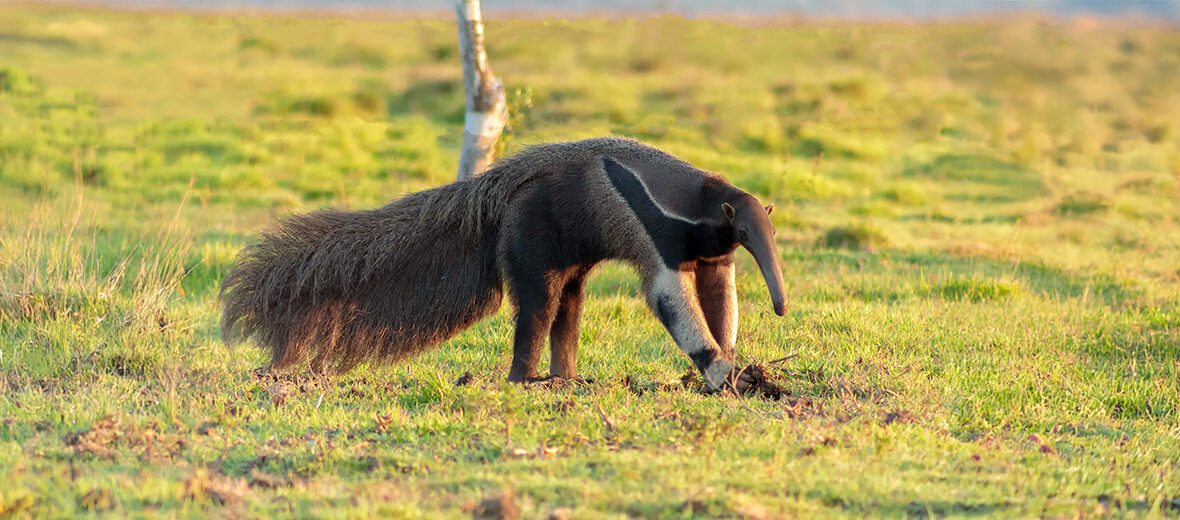
The giant anteater is the largest of the 4 species of anteaters. They hail from Central America and South America. The only extant member of the genus Myrmecophaga, they are classified with sloths in the order Pilosa. Unfortunately, they face many threats to their survival. The threats they are confronted with are habitat loss and destruction at the hands of residential and commercial developments, farming, ranching, fires, fire suppression; habitat division at the hands of roads and railroads, that can also cause vehicle strike – being hit by vehicles; hunting; trapping; invasive species that can bring predation and disease; pollution from the agricultural industry; and secondary poisoning. The IUCN lists these incredible creatures as Vulnerable, and their populations are decreasing.
First the Stats…
Scientific name: Myrmecophaga tridactyla
Weight: Up to 110 lbs.
Length: Up to 3.93+ feet, plus up to a 2.95+ foot tail
Height: Up to 3 feet
Lifespan: Up to 26 years
Now on to the Facts!
1.) There are fewer than 5,000 giant anteaters remaining as of 2024.
2.) They prefer rainforests and open grassland habitats.
3.) Even though they have no teeth and limited jaw movement, these anteaters can really pack away the ants and termites (the primary food of choice). Beetles and honey bees are also consumed.
4.) When eating they press their tongue against their palate to smash the insects for swallowing.
5.) The giant anteater doesn’t produce stomach acid on its own but rather digests its food using the formic acid of its prey.
But wait, there’s more on the giant anteater!
6.) They get their binomial name (the 2-part naming system for species, using Latin or Greek terms) from Carl Linnaeus in 1758.
7.) Giant anteaters have broad ribs and 5 toes on each foot. The 3 toes on the front feet have claws, which are rather large on the 3rd digits.
Did you know…?
Their tongue measures up to 24 inches! They are capable of flicking their tongue 160 times per minute, which equates to roughly up to 3 times per second.
8.) They walk on their front knuckles, just like chimpanzees and gorillas.
9.) Their body temperature is lower than that of most other mammals, at 91°F, compared to the normal 97°F – 100°F.
10.) These anteaters can be diurnal (active during the day) on cooler days, and nocturnal (active at night) on warmer days.
But wait, there’s still more on the giant anteater!
11.) These mostly terrestrial (spend their life on the ground) critters can also swim quite well, and will sometimes navigate large rivers.
12.) Males are more likely to engage in combat with one another than females. When 2 males get too close to each other, they will utter a “harr” sound and circle around each other. If the 2 don’t disperse a fight can break out that includes wrestling and slashing each other with their claws.
Did you know…?
These anteaters can consume up to 35,000 insects in a day.
13.) Attacking up to up to 200 nests in a day is commonplace. Each attack lasts a couple minutes.
14.) Sometimes soldier ants are able to thwart the advances of these anteaters via biting and stinging attacks.
15.) During mating a couple may stay together for up to 3 days and will mate multiple times during that time.
But wait, there’s still a little more on the giant anteater!
16.) Females undergo up to a 190 day gestation (pregnancy) that yields a single pup.
17.) While riding on its mother’s back the pup will camouflage against its mother by aligning its black and white band with hers.
Did you know…?
Between 2010 – 2012, 2 hunters were killed by giant anteaters in Brazil; and in both cases, the attacks appeared to be solely defensive behaviors. In April 2007, an anteater at the Florencio Varela Zoo managed to slash and kill a zookeeper with its front claws.
18.) Pup grooming and weaning ends in up to 10 months.
19.) Jaguars and pumas are their primary natural predators.
20.) While typically fleeing from danger, if cornered, they will rear up and slash with their formidable claws.
Now a Short Giant Anteater Video!
Be sure to share & comment below! Also, check out the Critter Science YouTube channel. Videos added regularly!
Want to suggest a critter for me to write about? Let me know here.
Some source material acquired from: Wikipedia & IUCN
Photo credit: Fernando Flores




